I met with Daniel Turner, Animal Welfare Director for Born Free in Europe. He has a place in Kemptown, by the sea. We’re lucky to have people from FFI, Born Free, Conservation Capital, ITAD and some other big players in the conservation world living in the same city as us.
When I eventually arrived puffing and sweating having just arrived on bike in the afternoon of one of the hottest days of the year, Daniel offered a drink and off we went. The penny dropped fairly soon into our meeting that this man’s knowledge and understanding of ecology, from both a political and scientific point-of-view is second only to his ability to explain them to someone such as myself, who knows little to nothing in comparison.
Having graduated in ecology at university, Daniel spent a time travelling in and around South America and ended up in Peru, where he discovered his passion for the natural world and, in particular, animals. He joined Born Fee 16 years ago and has since then steadily risen up through the ranks.
Born Free works in a multitude of areas on high profile campaigns to change public attitude on the environment and help persuade key decision makers on behalf of wildlife. It is an organisation whose mission it is to phase out animals in captivity, however large or small the enclosure. I wondered if this included keeping a stock of wildlife as a Plan B to restock wild Africa once wildlife falls to critical levels.
‘Well, the focus shouldn’t be so much on restocking but creating wildlife corridors so that animals in high density, low capacity areas can move into these new areas. What good is restocking if these animals don’t have the freedom to move around after they’ve been transferred – they’ll just be fair game all over again.’
I thought back to my undergrad lectures on genetic variation and pictured my lecturer talking about inbreeding. In a changing environment this can often be detrimental to a population as the population are less likely to have certain variations of alleles to cope with all possibilities of changes. All the more important with pollution, deforestation, land encroachment and climate change becoming more apparent than ever before.
‘Added to this, you have to think about logistics and cost. Tranquilising an animal as big as an elephant then relocating is always very risky in a lot of ways and very expensive.’
All of which dovetails neatly with the work of two charities that Wild Philanthropy, our sister venture, has had a lot to do with: Kenya-based Northern Rangelands Trust (NRT) and Tanzania’s Live Wildlife. NRT supports huge tracts of wilderness all attached by multitudes of wildlife corridors in Northern Kenya. Live Wildlife, run by Fabia Bausche and Nicholas Negre of Chem Chem Safari lodge, have helped restore a vital wildlife corridor in Burunge near Tarangire National Park – in 2014 they saw the first elephant crossing for almost 20 years and has begun to become a vital refuge for this wildlife.
I wondered about the recent CITES meetings in Johannesburg and what Daniel hoped would come out of it. This was complicated. One of his main hopes was a serious discussion on the trade of animal parts, particularly ivory of Africa’s rhinos and elephants. He explained that it’s impossible to just ‘put a ban’ on it. The rule of sovereignty means that countries can pretty much veto anything. The fact that Africa is a single continent where animals don’t pay heed to the borders creates complications to say the least.
‘Conservation has become very political’, he explains. ‘You have to look at the countries who are likely to import ivory and those who are likely to export it. Even if a country bans the export, illegal trades will still occur, so encouraging these countries to take stock counts of ivory is paramount to this. Even better if possession of ivory in these countries is made illegal – then no back logs have to be investigated, there is no confusion as to whether this or that piece of ivory has been around for two years or 200, it is just illegal.’ Increasingly large stock piles have been burnt in Kenya with the biggest yet in April, where 105 tonnes of elephant ivory and 1.5 tonnes of Rhino Ivory was set ablaze.
Until very recently, trading in animal parts didn’t have any regulations on it. Anyone could just go and shoot an elephant or lion, fly it back home, no questions asked through customs and hang it on their wall. In all African countries except for Kenya, where all trophy hunting is illegal, anyone hunting now needs to have a permit, which can be gained legally. Daniel explained that because permits can be acquired, the only way to stop the trade is to ban the import of animal goods into country’s where this is likely to happen. This and a number of other sneaky ‘work-arounds’ are currently being looked into by those at CITES. Showing the value (to local communities, regions and countries) of the live animal versus the dead one is an argument that still needs to be properly won.
Daniel summed up like this: Creating wildlife corridors to connect tracts of land are the only plausible way for the large animals of Africa to survive. The recent exponential increase in human population means we can no longer exploit natural resources like we once did. It is said that the average American consumes the same energy as 370 Ethiopians each year and if the earth’s population lived like Americans, we would need four earths to sustain us. This is part of the much wider issue. The least we conservationists can do while we strive to find smart solutions to cut down our consumption is to work to protect the wildlife – especially those species categorised as endangered.

